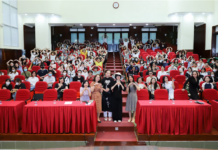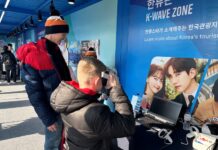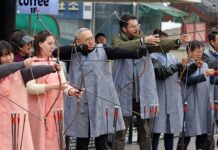
A lantern parade takes place on May 12, 10 days before Buddha’s birthday, through the heart of Seoul.
By Kim Hyelin, Park Hye Ri and Sohn JiAe
Photos = Heo Man-jin, Ministry of Culture, Sports and Tourism
Seoul l May 12, 2018
A parade of 100,000 lanterns lit up central Seoul on May 12, 10 days to go until Buddha’s birthday.
The lantern parade, often called the “flower of the celebration for Buddha’s birth,” brings together Buddhists to march together, holding lanterns that they made, every year. It’s something that goes beyond a merely religious event. It’s become a cross-cultural festival of about 1,200 years of history.
This year’s Seoul parade was led by a total of 19 North Korean lanterns based on images from ancient books, with the goal of praying for peace and unity on the Korean Peninsula. The North Korean lanterns retained their traditional looks with long frills and beacons of hope and peace hanging down from the lights.
Starting at 7 p.m., the march was led by more than 50,000 Korean and non-Korean Buddhists and secular citizens. Despite the rain, the raincoat-clad spectators welcomed with cheers and applause the marchers as they walked 4.5 km from Dongdaemun Gate all the way to Jogyesa Temple, chanting the blessing, “May you attain Buddhahood.”
Participants from Myanmar, Sri Lanka, Vietnam and Mongolia carried representative lanterns in the march from their countries. Among them were a group of children from Thailand and about 2,000 non-Korean marchers who themselves had signed on for the parade in advance.

One major float in the lantern parade that celebrates Buddha’s birthday in Seoul on May 12 features a juak bicheon (주악 비천), an imagery character who appears often on ancient Buddhist murals and temple bells.
In the middle of the parade was a giant lantern float that depicted a juak bicheon (주악 비천, 奏樂 飛天), an imagery female character from ancient Buddhist murals and temple bells who is presenting an offering to Buddha. The character, playing an instrument for Korean peace, garnered a lot of attention from the audience.
Large lanterns shaped like the Korean Peninsula with the words “Like-mindedness is the first step toward unification,” and also shaped like animals, dragons and a white elephant, were all part of the parade, leaving spectators in awe and busy capturing the sights with their cameras.
Minister of Culture, Sports and Tourism Do Jonghwan, too, was in the march, carrying a lantern together with representatives from various Buddhist sects.

Minister of Culture, Sports and Tourism Do Jonghwan waves as he marches with representatives from various Buddhist sects, in a lantern parade celebrating Buddha’s birthday in Seoul on May 12.
Ven. Seol Jeong, president of the Jogye Order of Korean Buddhism, said in a speech at a ceremony that took place before the festival that, “The bars that have long been between the two Koreas have started to be lifted since the Inter-Korean Summit in April. The following U.S.-North Korea Summit will bring the season of peace for which we have all dreamt, and it will spread around the world.”
“I believe that it’s you, the people, who have broken down the wall that all kinds of ideology and prejudice has made over the past years, and who have made Korea a country where many people enjoy their lives.
Rakesh Ranzan Samdarshi from India said that, “Buddhism originated in my country, but there’s no such thing as a lantern parade there. Even if it’s a certain religious festival, I could see many Koreans, whether they be religious or secular, enjoying the parade together, hoping for peace on the peninsula. I hope that we’ll have this kind of festival in India, too.”
Marcela Ramirez from Colombia said, “Even though I traveled to Korea for business with a tight schedule, I came here as I wanted to see this lantern festival up-close, here in Seoul. It’s surprising to see peoples from different nationalities and ages participating. I’m the most impressed by the lanterns, among other things, that looked like the Korean Peninsula.”
“What I liked the most was the way in which the parade participants played traditional musical instruments while dancing. They really enjoyed it. I’ll recommend my friends that they should make sure to check out this lantern parade,” said Sue Ossler from the U.S. who was traveling across the nation with her daughter.
Such lantern festivals that celebrate Buddha’s birthday take place not only in Seoul, but also in many other parts of the country, including Busan, Seosan in Chungcheongnam-do Province, on Jejudo Island, and in Daejeon, Incheon and Ulsan. Until May 22, the day of Buddha’s birthday, exhibitions that feature traditional lanterns will continue near Jogyesa Temple, Bongeunsa Temple in Samseong-dong and around the Cheonggyecheon Stream, all in Seoul.
hrhr@korea.kr























